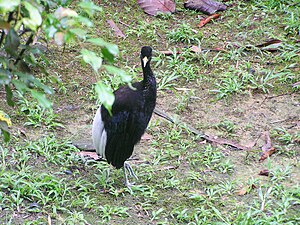White-winged Trumpeter Bird
| White-winged Trumpeter Bird | ||||||||||
|---|---|---|---|---|---|---|---|---|---|---|

White-winged Trumpeter Bird |
||||||||||
| Systematics | ||||||||||
|
||||||||||
| Scientific name | ||||||||||
| Psophia leucoptera | ||||||||||
| Spix , 1825 |
The White Wing Trompetervogel ( Psophia leucoptera ) is a 36 to 50 centimeter great representative of the family of trumpeter birds . The body weight is approx. 1 kilogram.
Appearance
These animals have black plumage except for the eponymous white wings. The beak is yellow and the strong legs are gray. Their strongly curved wings always keep them away from the body. The plumage sits loosely on their skin. The plumage looks velvety on the head and neck and fluffy on the back. The males are slightly larger than the females.
distribution and habitat
They occur in the rainforests of western Brazil , Peru and Bolivia . They avoid areas of their living space that have been redesigned by humans and withdraw into untouched areas of the jungle.
Way of life
They wander around the forest floor in smaller groups under the guidance of a lead animal. Their diet consists of berries, windfalls, worms, insects, especially ants and other molluscs. When danger threatens, they fly up the branches of higher trees or try to run away from the enemy on the ground. They are also good swimmers and go for a swim in shallow water. They spend the night in the canopy of higher trees. Life expectancy is around 10 years.
Reproduction
The males of the white-winged trumpeter bird have a strong, widely audible, humming, sometimes mooing voice, which they sound during the mating season. During the courtship season, the males puff themselves up in front of the females and show their magnificent metallic shimmering plumage on the front neck. Only the most dominant female mates with several males. During the breeding season, usually in March or April, the female builds her nest in low tree heights or right on the ground. It consists only of a few blades of grass. The clutch consists of 6 to 10 dirty white eggs with rough shells. The weight of a single egg is approx. 76 grams. The incubation period is 23 days. The breeding business and the rearing of the young is only done by the female. After hatching, the young are immediately independent and go looking for food together with the adult birds. The young birds have dense, dark down plumage for better camouflage.
Hazards and protective measures
Since this species is slowly declining, it has been classified as potentially endangered by the IUCN ( Near Threatened ). The reasons for this are hunting, logging and the conversion of their living space into agricultural land. To protect the species, several protected areas have been designated in their habitat.
use
The natives of the area around their habitat keep these animals because of their song. He also warns of dangers such as wild animals in a very loud voice.
literature
- The great world empire of the animals Page: 228, 229 Publisher: Planet Media AG, Zug 1992 ISBN 3-8247-8614-1
- The animal world of America in color Page: 40.41 Publisher: Karl Müller Verlag Erlangen 1989
- Wilhelm Eigner Encyclopedia of Animals Volume 2 Page: 317 Publisher: Weltbild Verlag 1999 ISBN 3-89350-361-7
- THE BLV Encyclopedia Birds of the World Page: 213 BLV Buchverlag GmbH & Co. KG Munich 2004 ISBN 3-405-16682-9
Web links
- Psophia leucoptera inthe IUCN Red List of Threatened Species 2019.1. Listed by: BirdLife International, 2016. Retrieved March 12, 2019.